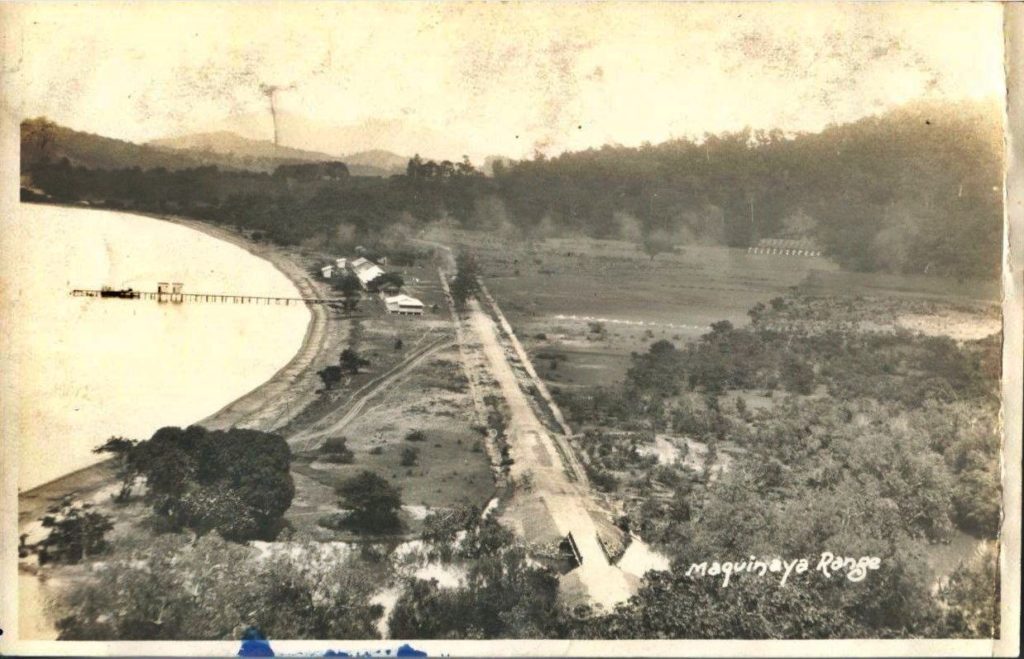
Zc728. This is a 1930 image of the Navy Rifle Range (a better description would be to call it the Marine Corps Rifle Range) located in the area called Maquinaya, This area became Barrio Barretto. The river is still called Maquinaya River. This picture was provided by my Marine friend Bert Caloud.
——————————–
Barrio Barretto, now an important tourist spot, was called Maquinaya before WWII and has a Military History. We senior Navy Petty Officers liked to hang out here vice in Olongapo with its Super Club hassles; here it was more like a country atmosphere. But before WWII it was exclusively used by the US. Naval Forces, it was a shooting range and was used for field training by the Marines. In 1945 it became the Subic Bay Naval Supply Depot. In 1950 (I’m not sure about the accurate date) it was turned over to the Philippine Authorities. Then, first it was a hangout for people like me and then it became a large community and tourist spot.
———————————–
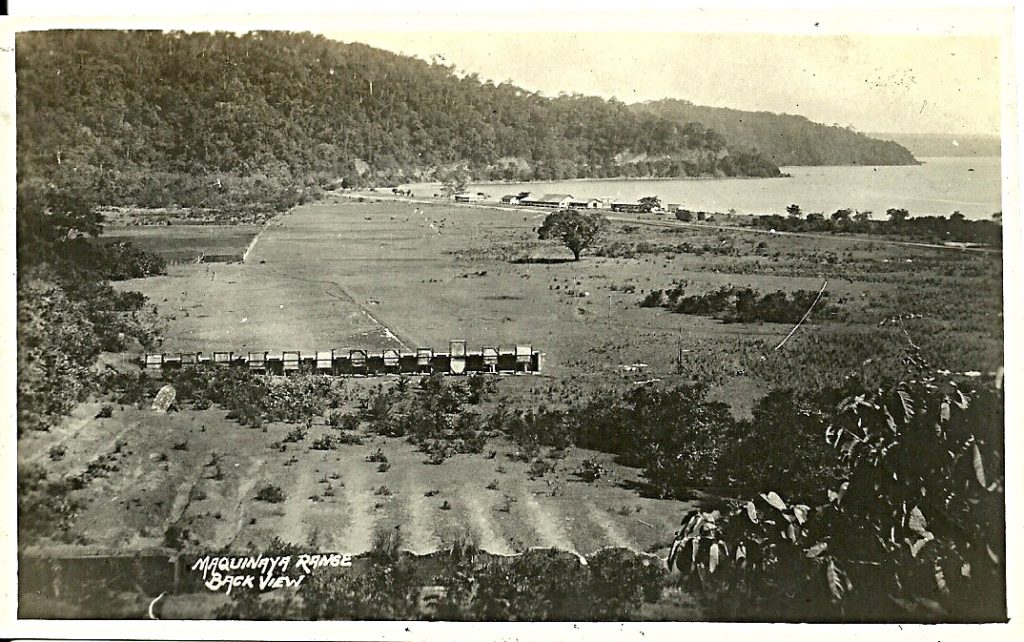
Zc729. This is the back view of a 1930 image of the Navy Rifle Range (a better description would be to call it the Marine Corps Rifle Range) located in the area called Maquinaya, This area became Barrio Barretto. The river is still called Maquinaya River. This picture was provided by my Marine friend Bert Caloud.
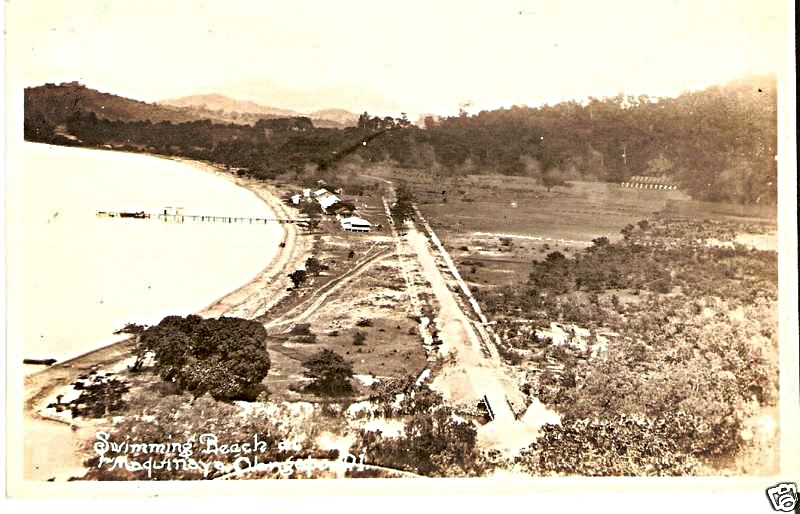
Zc730. This is a 1930 image of the Navy Rifle Range (a better description would be to call it the Marine Corps Rifle Range) located in the area called Maquinaya. It was also a swimming beach; the public beach is now called: Driftwood Beach. This area became Barrio Barretto. The river is still called Maquinaya River. This picture was provided by my Marine friend Bert Caloud. My house stands now about where the range targets are.
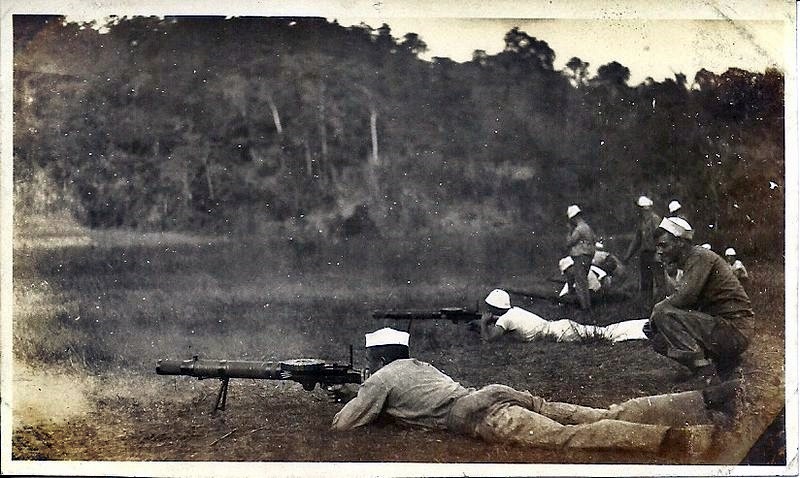
Zc731. The picture says “Olongapo Rifle Range” and it is from the 1920s. We can safely assume this in the Maquinaya area because history says the Navy Rifle Range was here. This picture was provided by my Marine friend Bert Caloud.
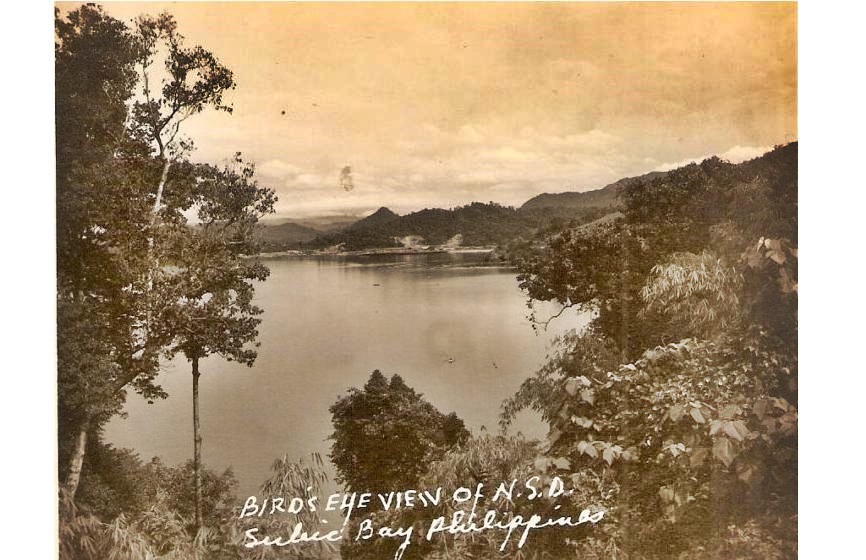
Zc732. NSD means Naval Supply Depot and this is dated 1950; there is no doubt in my mind that the area pictured is where Barrio Barretto is now and which used to be the Maquinaya area. Kalaklan Point just got onto the picture also at right.
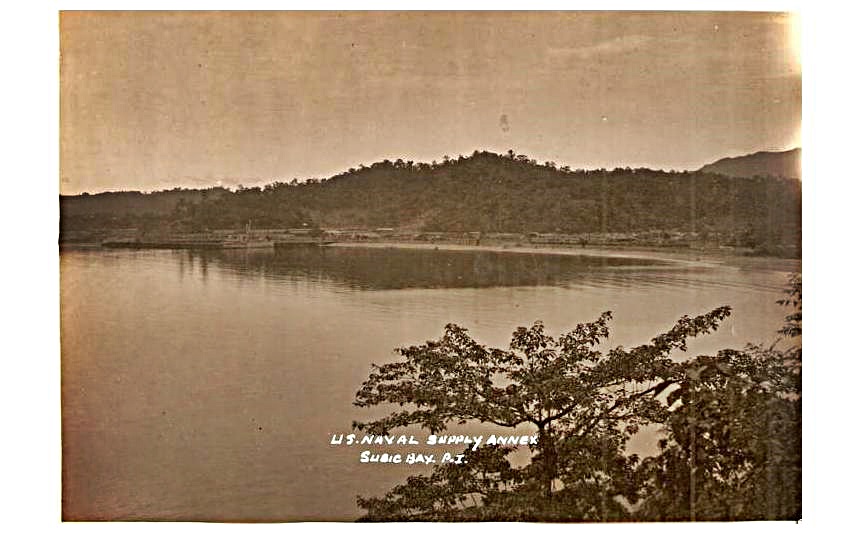
Zc733. Here is the same area and is called the Supply Annex; in this picture you can make out a large pier and a small vessel is moored to it. If you compare this ridge line with the one in the last image (ZC732) you must be convinced, like I am, that is the same ridge.
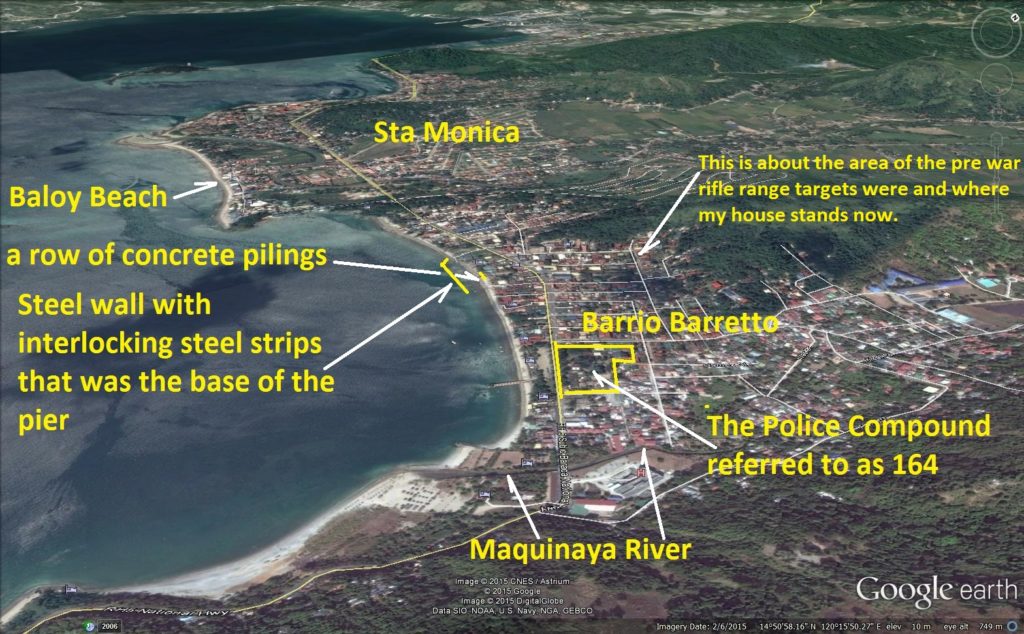
Zc734. What a change, this is Barrio Barretto now! I tried to angle this Google Earth image like image #Zc728 and marked it with some relevant points in this album. The pictures # Zc732 and Zc733 show the Navy supply place which is called Naval Supply Depot (NSD) or Naval Supply Annex, it was built in 1945 and was used a number of years. This is located in the area that is called Barrio Barretto now (where I live now). I marked the approximate location of the pier on this Google Earth image. The next 7 images show what is left of the pier as of Sep. 2015.
—————————————
Here are 6 pictures that show what is left of the Navy Supply Depot Pier, built in 1945, here in the former Maquinaya which has become the Barrio or barangay Barretto.
—————————————–
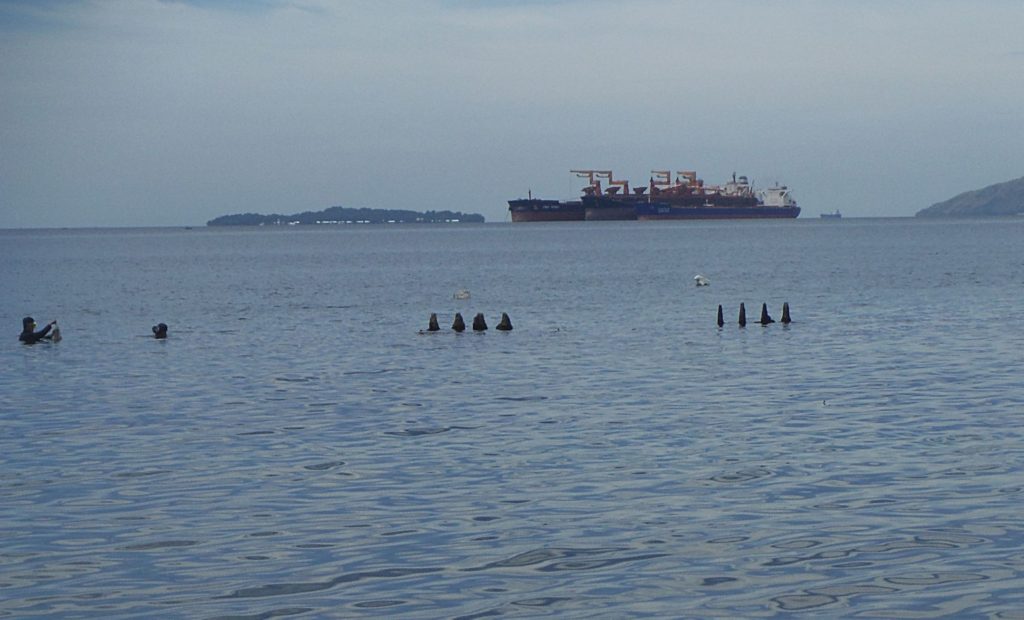
Zc735. This is what is left over from the steel wall built with the interlocking steel strips, about a foot wide and ½ inch thick or more. This was the Navy Pier, built in 1945, for the Supply Depot in this area, called Maquinaya then, which is now called Barrio Barretto. We see a fisherman skin diving around the former pier. In the back of this image we see Grande Island in Subic Bay and a nest of ships that transloads iron ore from a big ship with Brazilian iron ore to a smaller ship going to Red China.
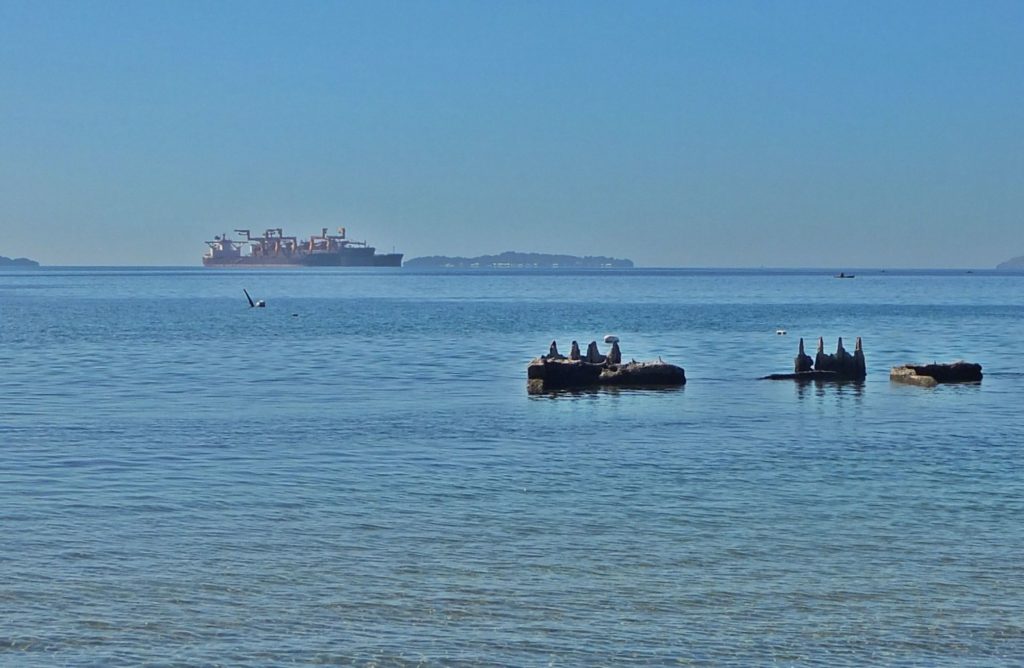
Zc736. This is what is left over from the steel wall built with the interlocking steel strips, about a foot wide and ½ inch thick or more. This was the Navy Pier, built in 1945, for the Supply Depot in this area, called Maquinaya then, which is now called Barrio Barretto. We see a fisherman skin diving around the former pier. In the back of this image we see Grande Island in Subic Bay and a nest of ships that transloads iron ore from a big ship with Brazilian iron ore to a smaller ship going to Red China. This shot is at a real low tide.
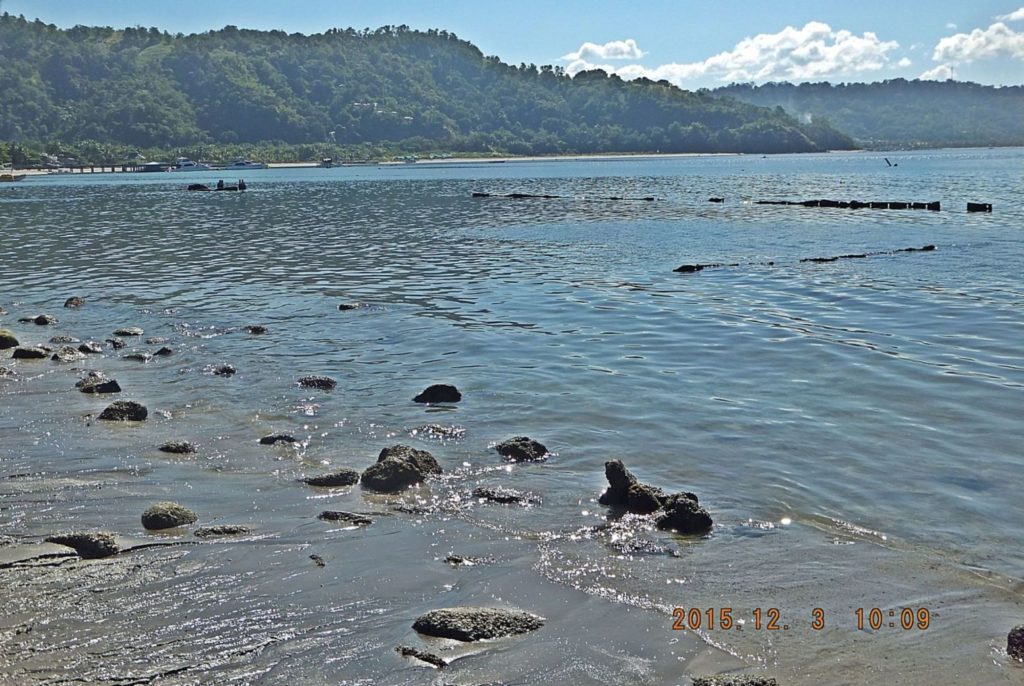
Zc737. The Navy supply pier was built with the interlocking steel strips, about a foot wide and ½ inch thick or more. Under water you can see it is at least 300 feet long and at the ends it turns inland with a right angle. Where I am standing now used to be a concrete base with a large bollard, time, saltwater and wave action made it disappear.
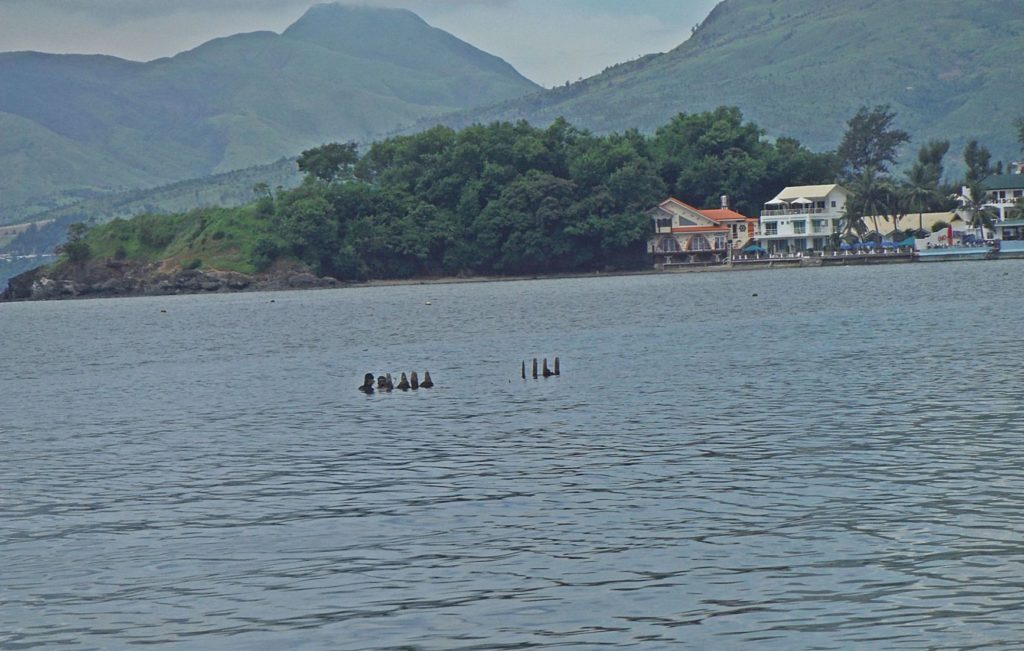
Zc738. Behind that point of land is where Baloy Beach starts and on an old Spanish map that point is called Mangalinocwin Pt. Those hotels are along the access road to Baloy Beach which were all built after the US Navy pulled out in 1992. Notice the two Filipinos fishing by skin diving.
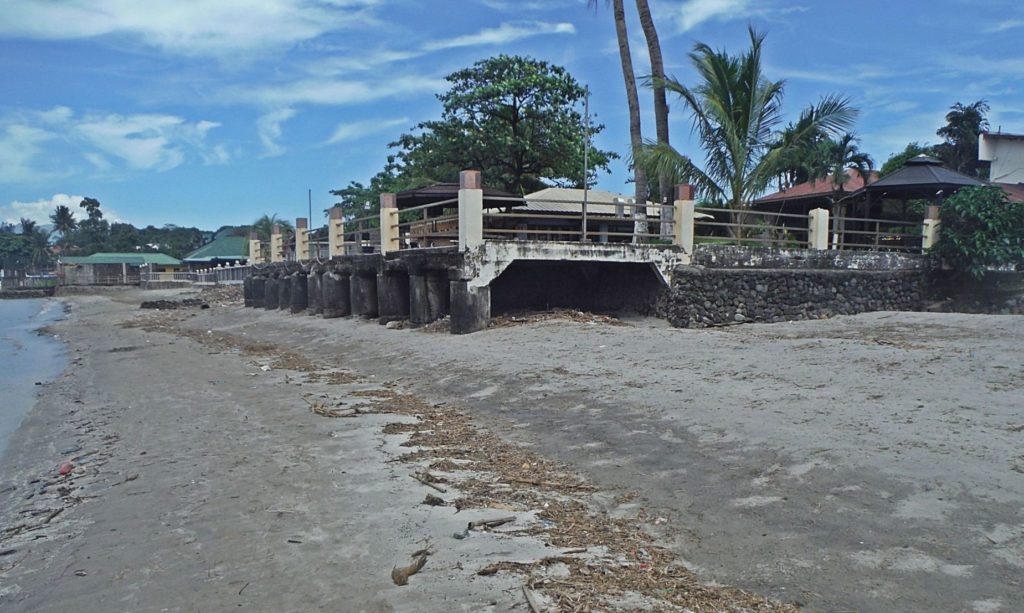
Zc739. The Navy pier in 1945 was located on this beach area in front of the hotels, By The Sea and Grand Seas, who are located there now. The former Navy pier must have connected to these concrete pilings.
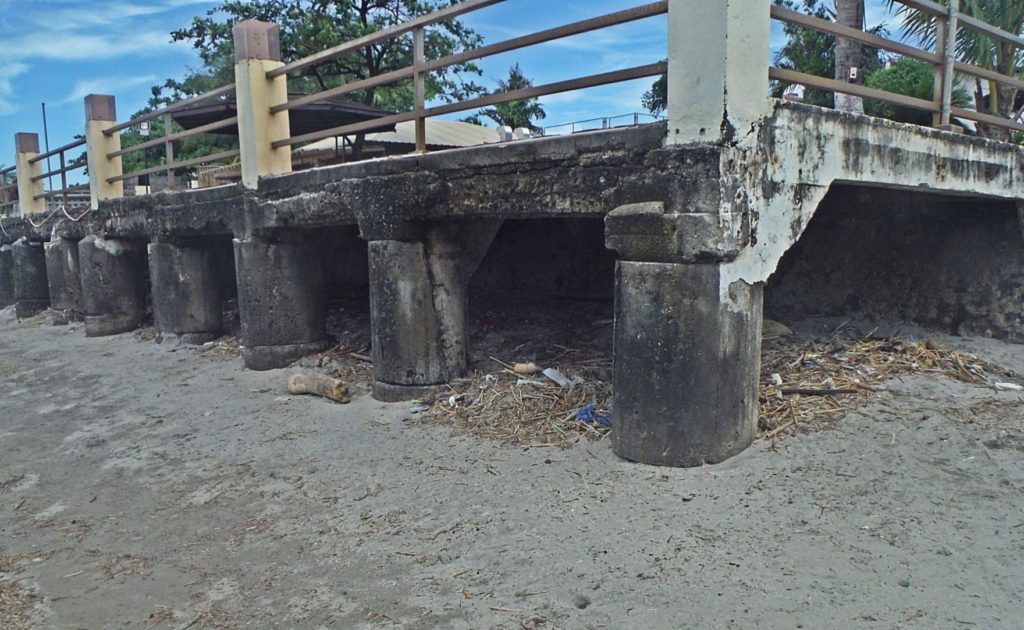
Zc740. This is a close-up of the last picture Zc728, these pilings and the concrete deck are located bay side of the Grand Seas Hotel. The former Navy pier must have connected to these concrete pilings.
————————————
Three special WWII pictures in the general Maquinaya (now Barretto) area.
————————————-
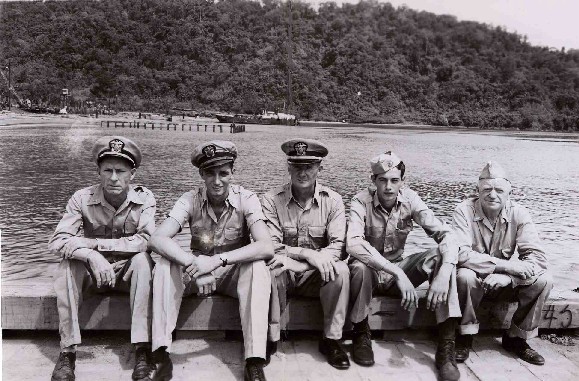
Zc741. Officers of the F.S.-182 at Subic Bay on Aug.22. 1946; engineering officer William Davidson is seated on the far right. The F. S.-182 was a U.S. Army supply ship and was manned by the Merchant Marine.
Note from Karl: There is no doubt in my mind that the officers are sitting on the Naval Supply Depot pier at the former Maquinaya, which is now Barrio Barretto, Olongapo City.
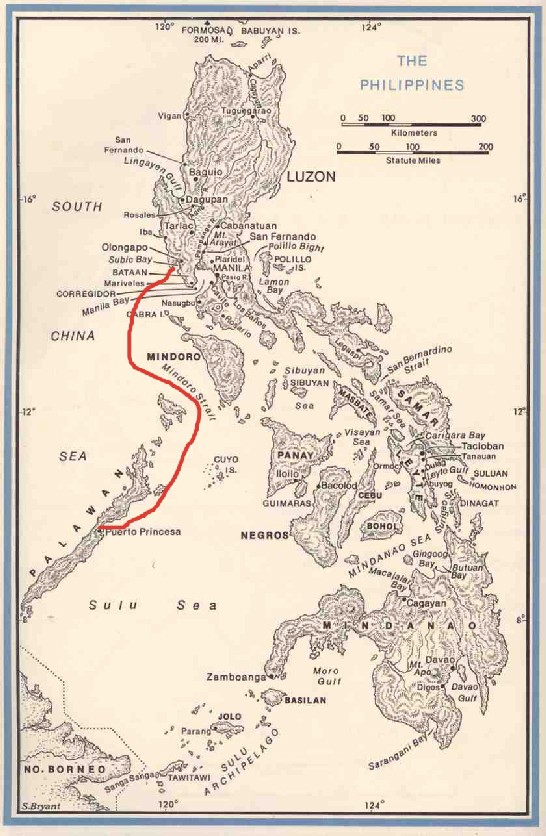
Zc742. This voyage of F. S.-182 was from Puerto Princesa on Palawan to Subic Bay. It had a very special cargo on board, the bodies of139 American Prisoners that were executed (Karl says murdered) by the Japanese on Dec. 14 1944 at the Puerto Princesa prison camp.
The above two pictures came from a California Valley Veterans web page, I cannot find it anymore.
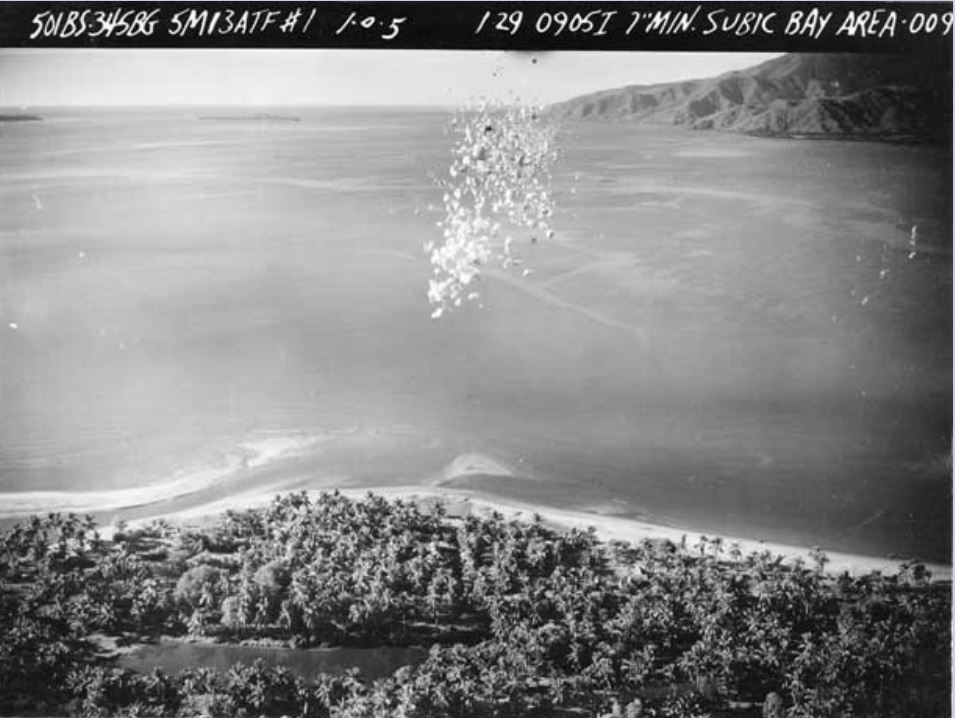
Zc743. Propaganda Leaflets dropped over Subic Bay in 1944 or 45. I can make out three landmarks, at left is Camaya Point of the former Naval Magazine, Grande Island (ex Fort Wint) is in the mouth of Subic Bay, and the right valley is the former Agusuhin Village, Marine Corps Green Beach and now the Hanjin Shipyard. This picture could have been shot from above the area between Maquinaya and the present White Rock Resort.
This image came from the State Library of South Australia where WWII intelligence images are stored and it is credited to Mr. Nicholas Kerr.
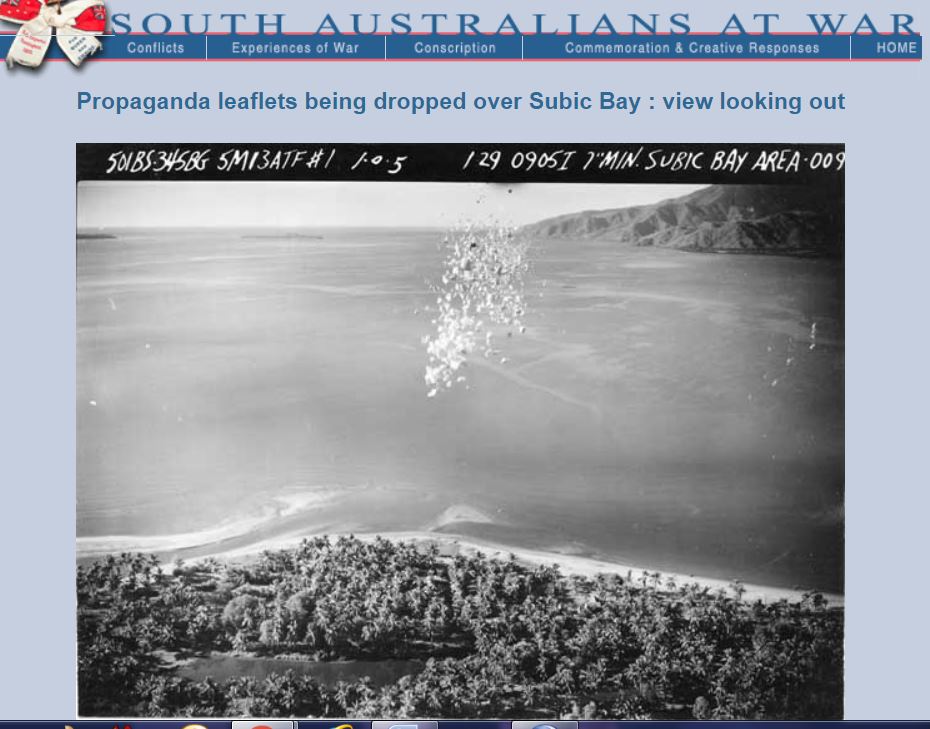
Zc744. Propaganda Leaflets dropped over Subic Bay in 1944 or 45. I can make out three landmarks, at left is Camaya Point of the former Naval Magazine, Grande Island (ex Fort Wint) is in the mouth of Subic Bay, and the right valley is the former Agusuhin Village, Marine Corps Green Beach and now the Hanjin Shipyard. This picture could have been shot from above the area between Maquinaya and the present White Rock Resort.
This image came from the State Library of South Australia where WWII intelligence images are stored and it is credited to Mr. Nicholas Kerr. I present this picture again for better source and credit information.
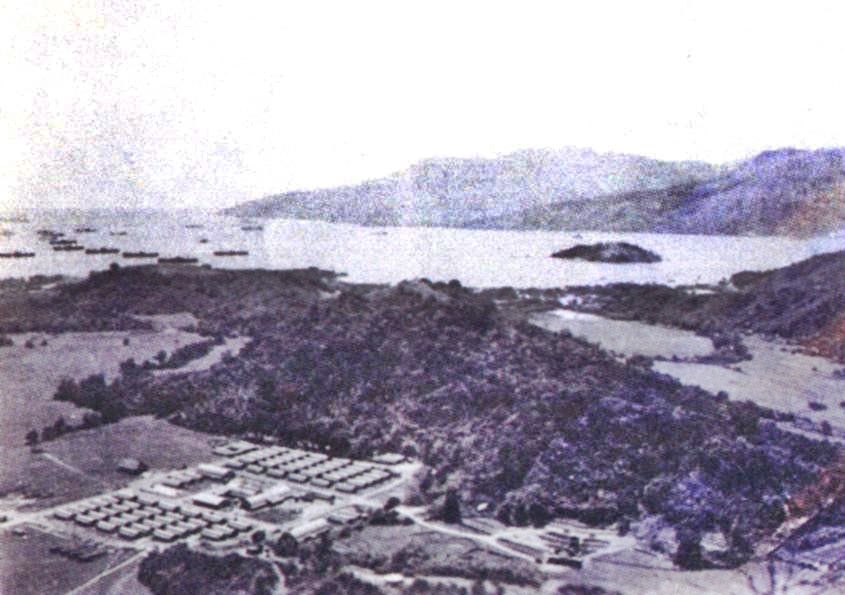
Zc745. This is a Seabee camp (Naval Construction Battalion, NCB) in the Matain River Valley in 1945. This is where barangay (village) San Isidro is located now; it belongs to the Subic Municipality. Along that ridge runs now the “Go Vic Subic Diversion Road”. In the Subic Bay area were at least three NCBs busy during that time, NCB-102, NCB-11 and NCB-133. This picture came from one of those NCB web pages.
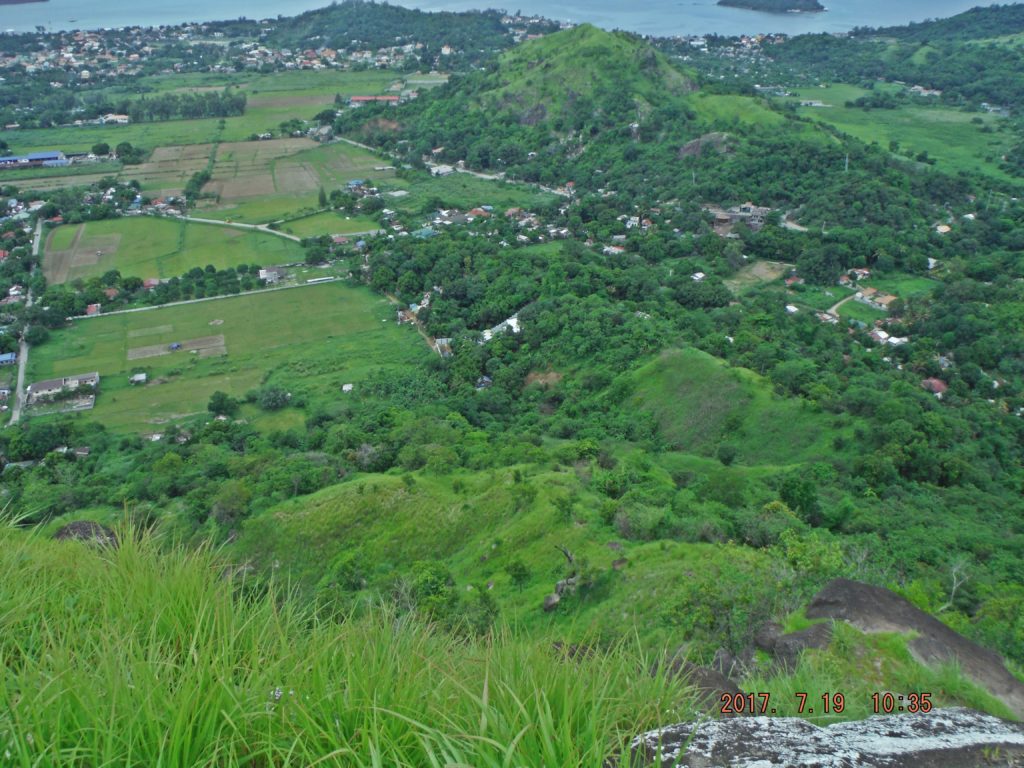
Zc746. This is a comparison picture of that Seabee Camp area, shot in July 2017.
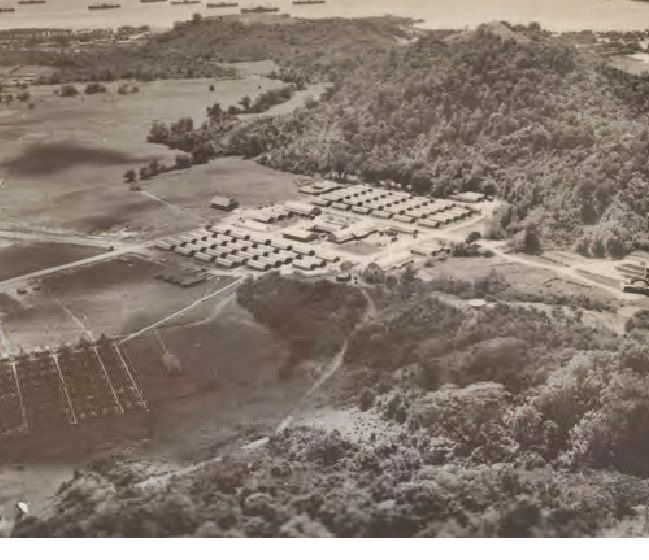
Zc747. This is a Seabee camp (Naval Construction Battalion, NCB) in the Matain River Valley in 1945. This is where barangay (village) San Isidro is located now; it belongs to the Subic Municipality. Along that ridge runs now the “Go Vic Subic Diversion Road”. In the Subic Bay area were at least three NCBs busy during that time, NCB-102, NCB-11 and NCB-133. This picture came from this great web page http://www.subicbaypi.com/
——————————-
The next 6 images are from the USS John D. Ford DD-228 and were sent to me by my Marine Friend Bert Caloud. The original description said the crew is at the Subic Bay Rifle Range in 1937 according to Bert. The rifle range at Maquinaya obviously was a proper equipped range, these pictures match that assertion. Some of the pictures do not show hills which are around the Maquinaya area and so I am not 100% sure these pictures are indeed of the rifle Range in the Maquinaya area.
The John D. Ford DD-228 served almost 2 decades in the Far East and survived the Battles of Badung Strait and Java Sea. The rest of the war she carried out mostly escort duties both in the Pacific and the Atlantic.
———————————-
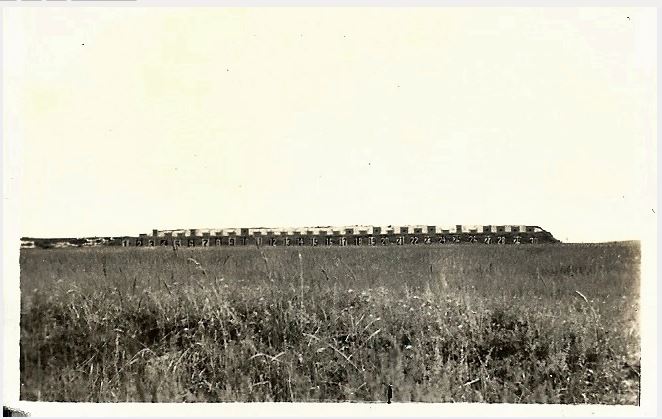
Zc748. This image is the 1st of 6 from the USS John D. Ford DD-228 and the original description said that the crew is on the Subic Bay Rifle Range in 1937. It is the first time I seen them and they were sent to me by Bert Caloud. The targets look like those at a real rifle range but I see no hills.

Zc749. This image is the 2nd of 6 from the USS John D. Ford DD-228 and the original description said that the crew is on the Subic Bay Rifle Range in 1937. It is the first time I seen them and they were sent to me by Bert Caloud. The first sailor is on the firing line.
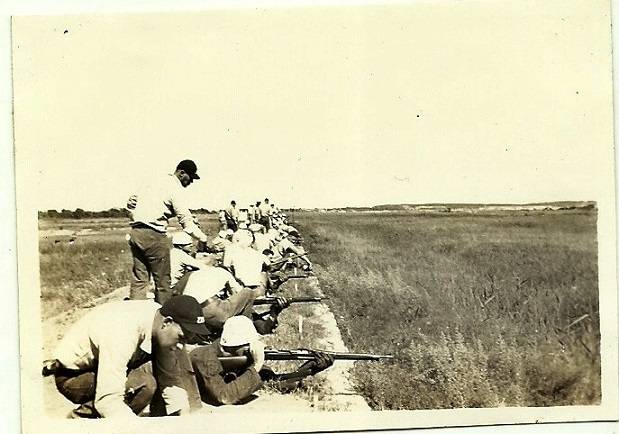
Zc750. This image is the 3rd of 6 from the USS John D. Ford DD-228 and the original description said that the crew is on the Subic Bay Rifle Range in 1937. It is the first time I seen them and they were sent to me by Bert Caloud. Gunners Mates instructing the sailors on the firing line.
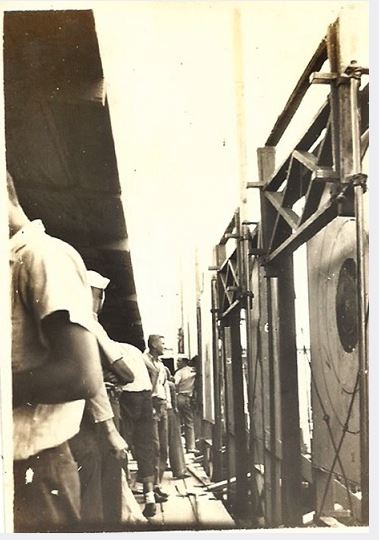
Zc751. This image is the 3rd of 6 from the USS John D. Ford DD-228 and the original description said that the crew is on the Subic Bay Rifle Range in 1937. It is the first time I seen them and they were sent to me by Bert Caloud. Other sailors are operating the targets.
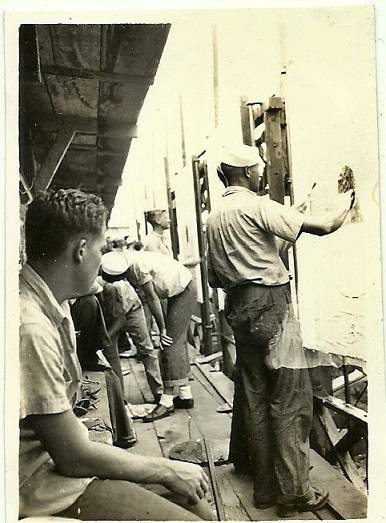
Zc752. This image is the 3rd of 6 from the USS John D. Ford DD-228 and the original description said that the crew is on the Subic Bay Rifle Range in 1937. It is the first time I seen them and they were sent to me by Bert Caloud. Other sailors are operating the targets.
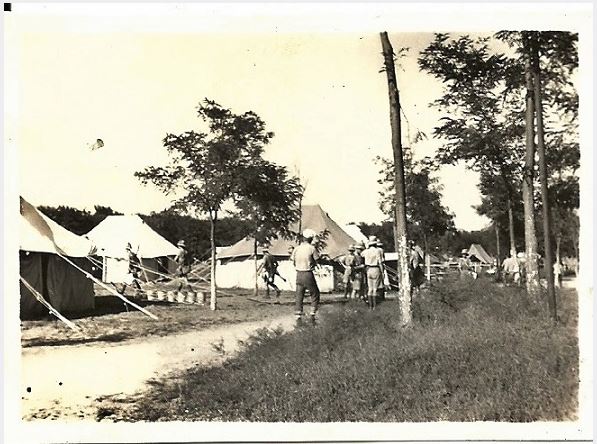
Zc753. This image is the 6th of 6 from the USS John D. Ford DD-228 and the original description said that the crew is on the Subic Bay Rifle Range in 1937. It is the first time I seen them and they were sent to me by Bert Caloud. It looks like that the DD Sailors are set-up in tents; maybe this was a field exercise for the ships landing party. And I see hills and the Maquinaya area was used for that purpose.
Karl, thank you. I share your material with Subic sailor friends. I was CO NSD Subic from 1980 to 1982. Three skippers in a row made Supply Corps flag. I retired as the 36th Chief of Supply Corps in 1991. Three times I have helped found charities to work in the Philippines. In 1981 it was Dick Gordon and I creating the Subic Bay Industrial Opportunists Foundation, to provide vocational training and jobs to young men. I am an honorary citizen of Olongapo. In 2001 it was the Subic Bay Alumni Foundation with Brian Buzzell. We provided money to the hospital, orphanage, typhoon relief, and sponsored military tours and the 2003 Subic Bay Reunion. Then came the CVCRA five years ago when Dennis Wriight and I fought to get ABMC to take over the Clark Cemetery. Today it is authorship of the Bells of Balangiga, Desk Gide to Truth and Brian, Dennis and I (three sailors) will get the Bells home. Now it is the Children of Marawi Project; medical and education for Marawi displaced families. Karl, I tell you all of this to acknowledge the value of the memories you create and to explain why I appreciate so much what you do to keep history alive. With great respect, Dan McKinnon 9-15-2018
Great collection, Karl. I agree with your observation that the 1937 images of the rifle range appear to show somewhere else. No mountain range behind that firing range.